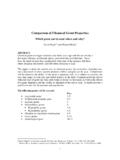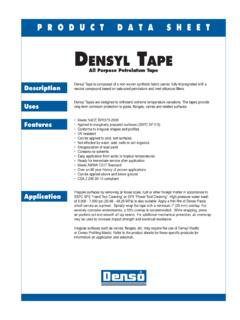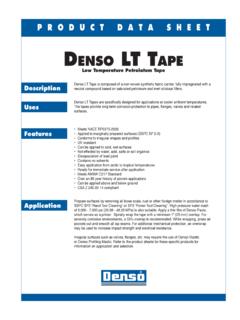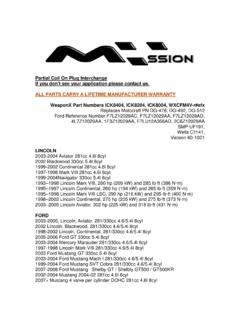Transcription of IN SITU PROTECTION OF SPLASH ZONES – 30 …
1 IN SITU PROTECTION OF SPLASH ZONES 30 YEARS ON Martin Smith & Colin Bowley Winn & Coales (Denso) Ltd Denso House, Chapel Road London SE27 0TR, UK Lucian Williams Denso North America Inc 18211 Chisholm Trail Houston, Texas 77060, USA ABSTRACT The corrosion rate in the SPLASH zone of marine piles is severe. Coatings for application in situ must provide PROTECTION even when applied to contaminated or immersed surfaces. Petrolatum tapes have been used for this application for 30 years and such systems are well established. Developments of this type of coating have been evaluated by laboratory tests and case histories and confirm that petrolatum tape systems with suitable outer coverings maintain long term corrosion PROTECTION of SPLASH ZONES and are unaffected by sulfate reducing bacteria (SRB).
2 INTRODUCTION Corrosion of steel structures in marine environments is a problem that has to be considered during both design and maintenance. The problems with corrosion control are probably best illustrated by jetty piles and wharf piling. Vertical piles pass through the whole range of marine environments from the mud line through total immersion, tidal zone, SPLASH zone and marine atmosphere. Not only are corrosion rates high but they vary according to the conditions in each zone. See Fig. 1. The most severe corrosion occurs in the SPLASH zone where corrosion rates are generally more than twice those in the immersed portion.
3 Above the SPLASH zone PROTECTION can be maintained by a range of coatings applied to a substantially dry and well-prepared surface. The immersed areas can be protected by cathodic PROTECTION . Maintenance of effective corrosion control is more difficult in the SPLASH and inter-tidal ZONES . There are more options for new work such as increasing the thickness of the steel to give a corrosion allowance, metallic coatings such as flame sprayed aluminium and various heavy-duty coatings applied before installation. The methods described in this paper are for the PROTECTION of piles and other structures in situ. A paper by W D Parker and W H Yeigh1 published in Materials Performance in 1972 described test programs and field experience with petrolatum tapes for SPLASH zone PROTECTION .
4 Over the 30 years since, the systems have been further developed and installed worldwide and several papers have been published on the subject2,3,4,5. Such systems are now well established where in situ application is required but questions concerning the level of PROTECTION , effects of bacteria and expected service life still arise. THE PROBLEM Corrosion rates for the various ZONES on marine piles are well published in various forms. Table 1 gives results from various sources for the maximum corrosion rate in the SPLASH zone and immersed zone for a range of locations. These show the maximum corrosion rates for the SPLASH zone in the range 150-500 m/y compared to the immersed zone at 60-140 m/y.
5 In a paper to NACE 2001 Rolf Lye6 referred to requirements for a corrosion allowance of 400 m/y for design. Use of cathodic PROTECTION would normally reduce the corrosion rate in the immersed zone to <25 m/y. Clearly, effective corrosion control measures are required at the SPLASH zone to ensure that design parameters are not exceeded. In practice the area protected needs to extend from below low water level to just above the SPLASH zone. Such measures are required where use of the structure is to be extended beyond the originally intended life. If such work is to be carried out in situ a coating system is required that can be installed reliably both above and below water and tolerate seawater contaminated surfaces.
6 For rehabilitation work it would also need to accommodate existing surface pitting. REQUIREMENTS OF THE COATING SYSTEM A successful coating for in-situ application shall: Allow application above and below water. Displace water from the metal substrate. Be surface tolerant. Fill pits and surface irregularities. Resist displacement by water. Be water resistant and resist saponification or emulsification. Resist microbiological action. Resist damage. Have long term weather resistance. Prevent corrosion or reduce it to a very low level. 02214\2 PETROLATUM TAPE SYSTEMS Petrolatum tapes have been used for the PROTECTION of buried, immersed or exposed steel structures since 1929.
7 The widening range of uses led to a series of long term exposure tests and investigations in the 1960 s. Much of this work, including marine exposures in the tidal/ SPLASH ZONES has been reported elsewhere2,3,5. This formed the basis for developing a protective system for marine piles using petrolatum tape and a protective outer covering. See Fig. 2. Development of a robust outer cover or jacket which could be applied to a pile in situ was considered essential for successful performance of the system. Initially jackets were preformed FRP half shells but these have been superseded by more user friendly and effective wraparound jackets.
8 Various types are used to suit the range of environments. Since the 1970 s the use of petrolatum tape systems on coastal jetties, harbors and moorings has been widespread involving a wide range of climates and sea conditions and PROTECTION for over 300,000m of piles has been provided worldwide by the authors company. This has required continuous innovation and development of the system and verification of performance. Development of a petrolatum tape that could be applied underwater without use of a primer considerably simplified application and this has been widely used for over 15 years. This tape can accommodate pit depths up to 2mm (80 mil) without use of a primer or filler.
9 The dewatering agent, inhibitor and biocide system in the tape promote adhesion to the metal and minimize the effects of any water or contaminants trapped under the tape. TESTING During the development of this type of tape laboratory tests were carried out by applying tapes to steel pipes under 3wt% sodium chloride solution and leaving them immersed for 3 years. The new tape without primer performed at least as well as the previous tape and primer system and considerably better than conventional petrolatum tapes used without primer. This was subsequently confirmed by field testing. A more recent series of tests confirms this.
10 Immersion in Aerated Salt Water. 60mm ( ) OD steel pipes were blast cleaned and wrapped dry and with the surface wetted with 1wt% sodium chloride solution. The wrapped pipes were immersed in 1wt% sodium chloride solution and air bubbled through the solution using a fish tank aerator. After 100 days the pipes were unwrapped and examined with the followings results. Wrapped Dry Wrapped Wet Standard Petrolatum Tape Nil corrosion 20% of area with heavy dark staining Petrolatum Tape with Dewatering Additive Nil corrosion 7% of area with light staining Specific Electrical Resistance This test was carried out to assess whether incorporation of dewatering and other additives would reduce water resistance as measured by a loss of electrical resistance.









